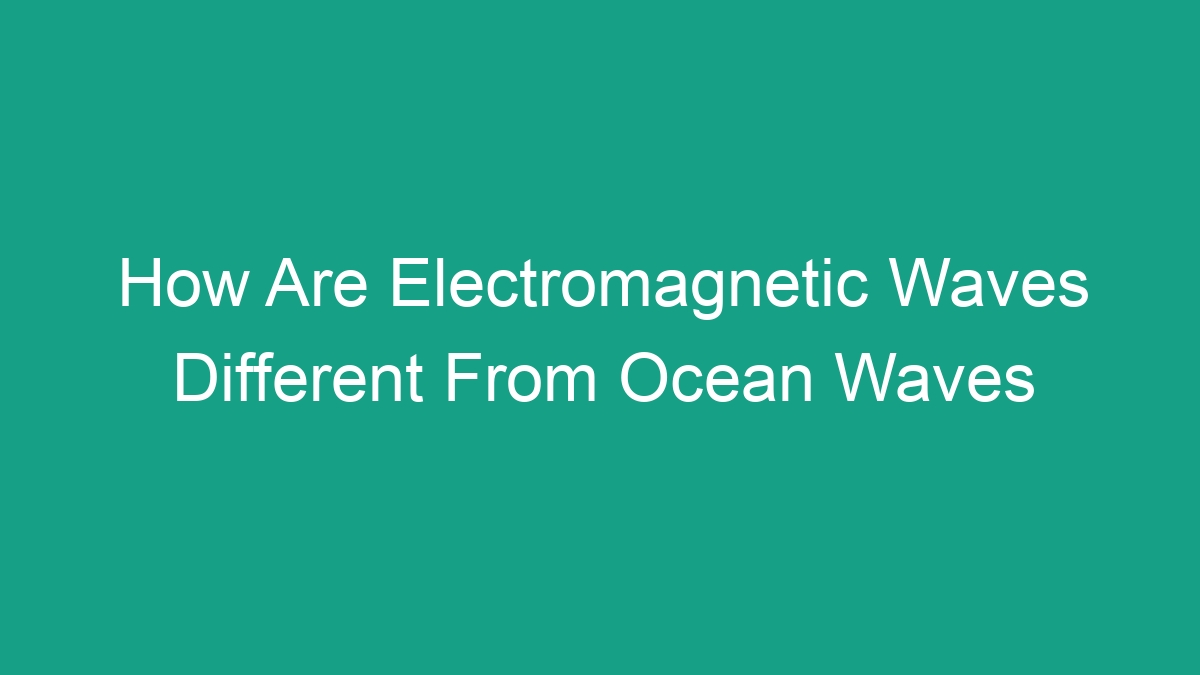
Understanding the fundamental differences between electromagnetic waves and ocean waves is crucial to gaining a deeper insight into the natural phenomena that surround us. Both types of waves play crucial roles in the functioning of our world, yet they operate on entirely different principles. In this article, we will explore the disparities between electromagnetic waves and ocean waves, delving into their definitions, characteristics, and applications.
Definitions of Electromagnetic Waves and Ocean Waves
Electromagnetic waves, also known as EM waves, are a form of energy that is created by the vibration of electric and magnetic fields. These waves are generated by the movement of electrically charged particles and are classified by their frequency and wavelength. They are capable of propagating through vacuum, as well as through various mediums such as air, water, and solid materials.
Ocean waves are a type of mechanical wave that result from the disturbance of the ocean’s surface. These waves are predominantly caused by the wind, as well as geological events such as earthquakes and underwater volcanic eruptions. Ocean waves transfer energy from one location to another, and their movement is influenced by factors such as wind speed, duration, and the area over which the wind blows.
Characteristics of Electromagnetic Waves and Ocean Waves
Electromagnetic Waves
- Travel at the speed of light
- Do not require a medium for propagation
- Can travel through a vacuum
- Can be classified by their frequency and wavelength
- Carry energy and information
- Examples include radio waves, microwaves, infrared, visible light, ultraviolet, X-rays, and gamma rays
Ocean Waves
- Depend on the medium (ocean water) for propagation
- Travel at varying speeds depending on the depth and distance from the shore
- Can be influenced by factors such as wind, tides, and storms
- Transfer energy over long distances
- Classified based on the characteristics of their waves, including height, length, and period
- Can cause erosion and shape coastal landscapes
Applications of Electromagnetic Waves and Ocean Waves
Electromagnetic Waves find a wide range of applications that are essential to modern life. From communication and information technologies to medical imaging and industrial processes, electromagnetic waves play a pivotal role in various fields.
| Electromagnetic Wave Type | Application |
|---|---|
| Radio waves | Wireless communication, broadcasting |
| Microwaves | Mobile phone communication, radar, heating food |
| Visible light | Human vision, illumination |
| X-rays | Medical imaging, security screening |
| Gamma rays | Cancer treatment, sterilization |
Ocean waves also have significant implications in various aspects of human life. From ocean transportation and energy generation to coastal protection and recreational activities, ocean waves serve as a valuable resource and source of inspiration.
| Ocean Wave Application | Utility |
|---|---|
| Wave energy | Renewable energy generation |
| Surfing | Recreational activity |
| Coastal protection | Preventing erosion, shaping coastlines |
| Shipping and navigation | Transporting goods, travel |
Distinguishing Factors Between Electromagnetic Waves and Ocean Waves
Several key differences can be identified between electromagnetic waves and ocean waves, contributing to their unique characteristics and behaviors:
Medium of Propagation
One of the fundamental distinctions lies in the medium through which these waves propagate:
- Electromagnetic waves can travel through vacuum and do not rely on a specific medium for propagation, whereas ocean waves are dependent on the ocean water for their movement.
Speed of Propagation
The speed at which electromagnetic waves and ocean waves travel also varies significantly:
- Electromagnetic waves travel at the speed of light, while ocean waves move at much slower speeds, influenced by the depth and distance from the shore.
Energy Transfer
Both types of waves are capable of transferring energy, albeit in different ways:
- Electromagnetic waves carry energy and information through their oscillating electric and magnetic fields, contributing to various applications such as communication, heating, and illumination.
- Ocean waves transfer energy over long distances, impacting coastal landscapes and playing a crucial role in ocean currents and ecosystems.
Conclusion
In conclusion, electromagnetic waves and ocean waves exhibit distinct characteristics and behaviors, each serving essential roles in our natural and technological environments. By understanding the disparities between these waves, we can gain a deeper appreciation for the complexities and interconnectedness of the world around us. Whether it’s the transmission of wireless communication through electromagnetic waves or the shaping of coastal landscapes by ocean waves, both phenomena continue to shape our lives in profound ways.
As we continue to explore and harness the power of these waves, their impact will undoubtedly shape the trajectory of our future endeavors, fueling advancements in technology, energy, and scientific discovery.
We hope this article has provided valuable insights into the unique properties of electromagnetic waves and ocean waves, offering a new perspective on the wonders of our natural world.




